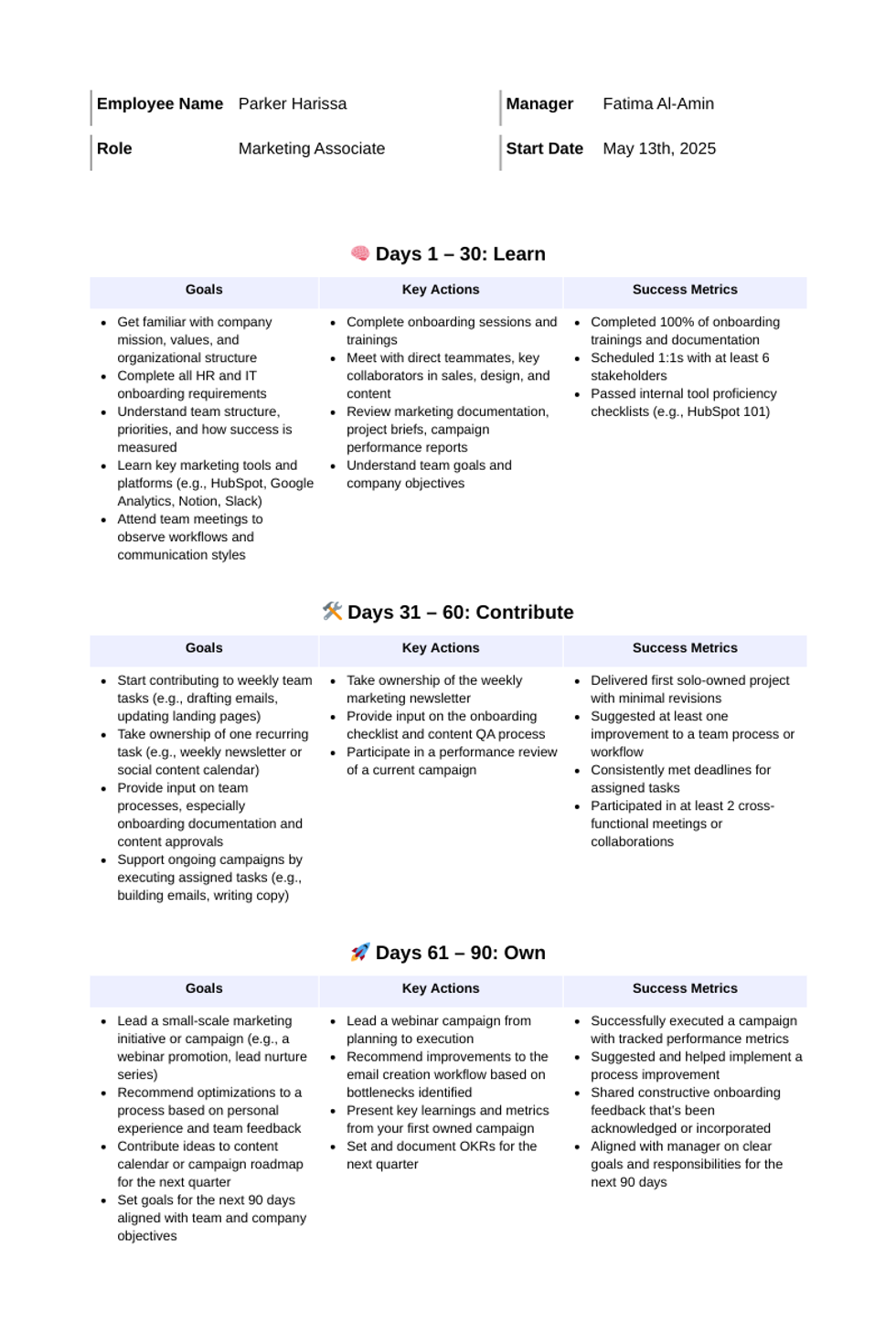Bringing someone new onto your team is exciting and…a little nerve-wracking. You've made the hire, now comes the tricky part: setting them up to succeed without overwhelming them (or your calendar).
Enter: the 30-60-90 day plan.
This framework gives structure and clarity to the first three months of any new role. It helps managers guide new employees with clear expectations. It helps HR teams build consistency into onboarding. And it helps new hires feel like they’re not just guessing their way through week one (and beyond!).
The plan breaks the first 90 days into three phases:
- 30 days of learning
- 60 days of planning and small wins
- 90 days of meaningful contribution
It's not complicated. But when done well, it’s powerful. It helps people ramp up faster, reduces turnover, and keeps everyone aligned from day one.
In this guide, you’ll learn how to create a 30-60-90 day plan that actually works, whether you're managing one hire or building a company-wide onboarding playbook. You’ll also get a free template and a few lessons we’ve learned the hard way.
📝 Free download: Onboarding Checklist Template
To successfully support a new hire's first 30, 60, and 90 days, you need a strong onboarding foundation. That’s why we’re including our Onboarding Checklist Template: to help you create a consistent, inclusive, and well-organized onboarding experience that sets the stage for success. This resource includes a step-by-step checklist, inclusive welcome tips, and tools to streamline the process, along with guidance to tailor it to your organization’s needs.
{Embed: Onboarding Checklist Template form}
What is a 30-60-90 day plan?
A 30-60-90 day plan is a simple roadmap that outlines what a new hire should focus on during their first three months on the job. It breaks the early ramp-up period into three clear phases:
- Days 1 – 30: Learn the ropes
- Days 31 – 60: Start contributing
- Days 61 – 90: Take ownership
This structure helps both new employees and managers. It creates shared expectations, helps track progress, and gives people a clear sense of direction. Instead of vague check-ins (“So… how are things going?”), you have specific milestones to refer to.
You can also customize these plans for different roles. For an individual contributor, the goals might be skill-based or tied to learning tools and workflows. For a manager, the plan could focus more on team relationships, strategy, and early leadership wins.
It’s not meant to be a rigid checklist. Think of it more like a flexible framework — a way to guide new employees without too much hand-holding.
Done well, a 30-60-90 day plan builds confidence, improves communication, and reduces the time it takes for someone to start adding value.
Read this next: 18 new hire onboarding survey questions to improve retention
Key components of an effective 30-60-90 day plan
Here’s what a well-built plan includes:
1. Clear goals
Each phase should have one or two primary goals. This doesn’t mean “stay afloat” targets, they’re meaningful outcomes tied to the role. A goal in the first 30 days might be “Meet with every team lead and document key workflows.” By day 90, it could be “Own and deliver one core project.”
2. Metrics that matter
What does success look like for that employee? Be specific. Maybe it’s launching a campaign, improving a process, or getting certified in a key tool. Whatever it is, tie it to performance — ideally, something measurable or observable.
3. Milestones and checkpoints
Set times to pause and reflect. End-of-month check-ins work well. Use them to adjust goals, gather feedback, and spot red flags early. You don’t want someone to feel like they’re being graded, but rather, like they don’t have to fly blind.
4. Key relationships
List the people they need to meet and why. Whether it’s cross-functional collaborators or the go-to Slack gurus, help them start building a network early. One missed intro can slow down a whole quarter and make for some awkward late intros.
5. Balance between learning and doing
Resist the urge to push for instant results. The first 30 days are all about context: the company, the culture, the tools, the team. Let them absorb before they act, then gradually shift the focus toward project execution.
Read this next: Building a stellar onboarding checklist
How to create a 30-60-90 day plan (step-by-step)
Days 1 – 30: Learn the landscape
This is typically the “drink from the firehose” stage — minus the chaos, if done well! The goal here is to help the new hire get settled.
What to focus on:
- Learn the company’s mission, structure, and tools
- Understand the team’s goals and how their role fits in
- Meet key stakeholders
- Shadow processes, observe workflows, and ask questions
Sample goals:
- Complete all onboarding modules
- Schedule 1:1s with team leads and cross-functional partners
- Review previous team projects and performance reports
- Build a working knowledge of key systems or platforms
Manager tip: Don’t overload the calendar with back-to-back meetings. Give space to absorb and reflect. And encourage questions. Lots of them.
Days 31 – 60: Start contributing
Now that the lay of the land is clearer, it’s time to get more involved. This phase is all about building confidence and delivering early wins.
What to focus on:
- Apply what’s been learned
- Take ownership of a small project or task
- Identify gaps or inefficiencies
- Start giving input in meetings
Sample goals:
- Lead one team update or internal presentation
- Offer feedback on a process the team uses
- Take ownership of a recurring task
- Suggest one improvement to the onboarding process
Manager tip: These “small wins” don’t have to be flashy, they just need to show initiative. Recognize progress (even if it’s small or low-key).
Days 61 – 90: Take ownership
The training wheels are (mostly) off. The new hire should be able to run with more complex work and contribute in a real way.
What to focus on:
- Deliver on larger responsibilities
- Strengthen internal relationships
- Share feedback and ideas for future work
- Set goals for the next quarter
Sample goals:
- Launch a project with clear outcomes
- Build or refine a process
- Present a short-term roadmap for their role
- Provide feedback on the onboarding experience
Manager tip: Use the 90-day mark as a two-way checkpoint. Ask: “What’s working?” and “What could be better?” Adjust your course if needed, and iterate on what’s successful or needs to be improved.
This phased approach gives structure without leaning on a script. It also leaves room for the human side of onboarding (curiosity, questions, and the occasional curveball).
Check this out next: New course on inclusive onboarding
Common mistakes to avoid
Even the best 30-60-90 day plan can flop if you’re not careful. The good news? Most missteps are avoidable or correctable. Here are a few to keep on your radar:
1. Making the plan too rigid
Life happens, projects shift, and priorities change. A good plan should be able to bend without breaking. Treat it like a living document, not a stone tablet. Check in, tweak it, and give the new hire some ownership in shaping it.
2. Skipping stakeholder input
Don’t build the plan in a vacuum. If you’re the manager, loop in HR or other department leads early, or consider asking other team members what worked well for them. If you’re in HR, encourage managers to tailor the plan to the specific role and team. One-size-fits-all usually ends up fitting no one.
3. Focusing only on tasks, not context
Sure, completing tasks is important. But so is learning the “why” behind the work. Make space for culture, values, team dynamics, and strategic goals. People work better when they understand the big picture.
4. Overloading the first 30 days
You don’t need to cram everything into week one. In fact, we recommend you don’t try, because too much information leads to burnout, not brilliance. Give new hires time to ramp up!
5. Forgetting to follow up
A plan without checkpoints is just a PDF sitting in someone’s inbox. Schedule regular syncs to check progress, troubleshoot issues, and celebrate small wins. That means that, no, you can’t ghost your own plan.
Free template: Build your own 30-60-90 day template
Below is a copy-and-paste 30-60-90 day template you can drop straight into a doc, email, or onboarding checklist.
Use it as-is, or tweak it to fit the role and team.
30-60-90 Day Template
Employee Name:
Role:
Manager:
Start Date:
📘 Days 1 – 30: Learn
Goals:
- [Include 5 - 10 actionable goals]
Key actions:
- Complete onboarding sessions and trainings
- Meet with [list key stakeholders or team members]
- Review [insert tools, processes, or documentation]
- Understand team goals and company objectives
Success metrics:
- [Include 3 - 5 measurable outcomes]
🛠 Days 31 – 60: Contribute
Goals:
- [Include 5 - 10 actionable goals]
Key actions:
- Take ownership of a small project or recurring task [specify which]
- Provide input on workflows or team processes [specify which]
- Begin cross-functional collaboration [specify where/ how]
- [Include other relevant tasks]
Success metrics:
- [Include 3 - 5 measurable outcomes]
🚀 Days 61 – 90: Own
Goals:
- [Include 5 - 10 actionable goals]
Key actions:
- Lead a project or initiative [specify which]
- Recommend improvements or optimizations [specify where/ how]
- Share feedback on the onboarding experience
- Set goals for the next 90 days
- [Include other relevant tasks]
Success metrics:
- [Include 3 - 5 measurable outcomes]
Feel free to tailor this to suit different levels, from interns to senior leaders. The format stays the same — the impact just scales with the role.
Here’s a completed example of the template:
(Yup, it’s that easy!)
And keep in mind, there’s no perfect way to start a new job, but there is a smart one. A well-structured 30-60-90 day plan gives everyone a good chance at success: the new hire, the manager, and the company.
Want to set your new hires up for long-term success? Schedule a demo with PowerToFly to see how we help companies attract and retain top talent through inclusive, intentional hiring strategies.
{Embed: Contact us form}





